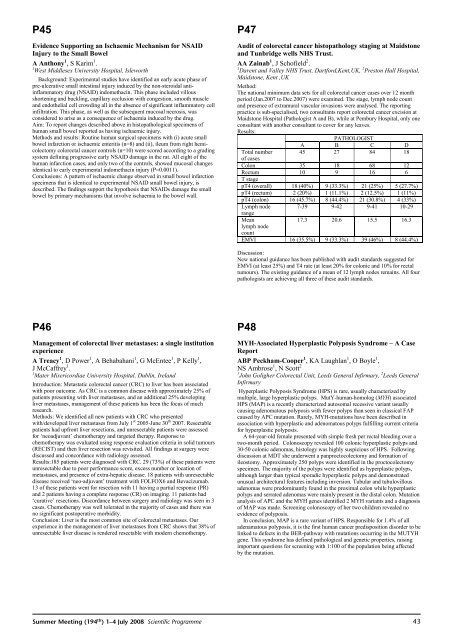2008 Summer Meeting - Leeds - The Pathological Society of Great ...
2008 Summer Meeting - Leeds - The Pathological Society of Great ...
2008 Summer Meeting - Leeds - The Pathological Society of Great ...
You also want an ePaper? Increase the reach of your titles
YUMPU automatically turns print PDFs into web optimized ePapers that Google loves.
P45Evidence Supporting an Ischaemic Mechanism for NSAIDInjury to the Small BowelAAnthony 1 ,SKarim 1 .1 West Middlesex University Hospital, IsleworthBackground: Experimental studies have identified an early acute phase <strong>of</strong>pre-ulcerative small intestinal injury induced by the non-steroidal antiinflammatorydrug (NSAID) indomethacin. This phase included villousshortening and buckling, capillary occlusion with congestion, smooth muscleand endothelial cell crowding all in the absence <strong>of</strong> significant inflammatory cellinfiltration. This phase, as well as the subsequent mucosal necrosis, wasconsidered to arise as a consequence <strong>of</strong> ischaemia induced by the drug.Aim: To report changes described above in histopathological specimens <strong>of</strong>human small bowel reported as having ischaemic injury.Methods and results: Routine human surgical specimens with (i) acute smallbowel infarction or ischaemic enteritis (n=8) and (ii), ileum from right hemicolectomycolorectal cancer controls (n=10) were scored according to a gradingsystem defining progressive early NSAID damage in the rat. All eight <strong>of</strong> thehuman infarction cases, and only two <strong>of</strong> the controls, showed mucosal changesidentical to early experimental indomethacin injury (P=0.0011).Conclusions: A pattern <strong>of</strong> ischaemic change observed in small bowel infarctionspecimens that is identical to experimental NSAID small bowel injury, isdescribed. <strong>The</strong> findings support the hypothesis that NSAIDs damage the smallbowel by primary mechanisms that involve ischaemia to the bowel wall.P47Audit <strong>of</strong> colorectal cancer histopathology staging at Maidstoneand Tunbridge wells NHS Trust.AA Zainab 1 , J Sch<strong>of</strong>ield 2 .1 Darent and Valley NHS Trust, Dartford,Kent,UK, 2 Preston Hall Hospital,Maidstone, Kent ,UKMethod:<strong>The</strong> national minimum data sets for all colorectal cancer cases over 12 monthperiod (Jan.2007 to Dec.2007) were examined. <strong>The</strong> stage, lymph node countand presence <strong>of</strong> extramural vascular invasions were analysed. <strong>The</strong> reportingpractice is sub-specialised, two consultants report colorectal cancer excision atMaidstone Hospital (Pathologist A and B), while at Pembury Hospital, only oneconsultant with another consultant to cover for any leaves.Results:PATHOLOGISTA B C DTotal number 45 27 84 18<strong>of</strong> casesColon 35 18 68 12Rectum 10 9 16 6T stagepT4 (overall) 18 (40%) 9 (33.3%) 21 (25%) 5 (27.7%)pT4 (rectum) 2 (20%) 1 (11.1%) 2 (12.5%) 1 (11%)pT4 (colon) 16 (45.7%) 8 (44.4%) 21 (30.8%) 4 (33%)Lymph node 7-39 9-42 9-41 10-29rangeMean17.3 20.6 15.5 16.3lymph nodecountEMVI 16 (35.5%) 9 (33.3%) 39 (46%) 8 (44.4%)Discussion:New national guidance has been published with audit standards suggested forEMVI (at least 25%) and T4 rate (at least 20% for colonic and 10% for rectaltumours). <strong>The</strong> existing guidance <strong>of</strong> a mean <strong>of</strong> 12 lymph nodes remains. All fourpathologists are achieving all three <strong>of</strong> these audit standards.P46Management <strong>of</strong> colorectal liver metastases: a single institutionexperienceA Treacy 1 ,DPower 1 , A Behabahani 1 , G McEntee 1 , P Kelly 1 ,J McCaffrey 1 .1 Mater Misericordiae University Hospital, Dublin, IrelandIntroduction: Metastatic colorectal cancer (CRC) to liver has been associatedwith poor outcome. As CRC is a common disease with approximately 25% <strong>of</strong>patients presenting with liver metastases, and an additional 25% developingliver metastases, management <strong>of</strong> these patients has been the focus <strong>of</strong> muchresearch.Methods: We identified all new patients with CRC who presentedwith/developed liver metastases from July 1 st 2005-June 30 th 2007. Resectablepatients had upfront liver resections, and unresectable patients were assessedfor ‘neoadjuvant’ chemotherapy and targeted therapy. Response tochemotherapy was evaluated using response evaluation criteria in solid tumours(RECIST) and then liver resection was revisited. All findings at surgery werediscussed and concordance with radiology assessed.Results:185 patients were diagnosed with CRC. 29 (73%) <strong>of</strong> these patients wereunresectable due to poor performance score, excess number or location <strong>of</strong>metastases, and presence <strong>of</strong> extra-hepatic disease. 18 patients with unresectabledisease received ‘neo-adjuvant’ treatment with FOLFOX6 and Bevacizumab.13 <strong>of</strong> these patients went for resection with 11 having a partial response (PR)and 2 patients having a complete response (CR) on imaging. 11 patients had‘curative’ resections. Discordance between surgery and radiology was seen in 3cases. Chemotherapy was well tolerated in the majority <strong>of</strong> cases and there wasno significant postoperative morbidity.Conclusion: Liver is the most common site <strong>of</strong> colorectal metastases. Ourexperience in the management <strong>of</strong> liver metastases from CRC shows that 38% <strong>of</strong>unresectable liver disease is rendered resectable with modern chemotherapy.P48MYH-Associated Hyperplastic Polyposis Syndrome – A CaseReportABP Peckham-Cooper 1 , KA Laughlan 1 ,OBoyle 1 ,NS Ambrose 1 ,NScott 21 John Goligher Colorectal Unit, <strong>Leeds</strong> General Infirmary, 2 <strong>Leeds</strong> GeneralInfirmaryHyperplastic Polyposis Syndrome (HPS) is rare, usually characterized bymultiple, large hyperplastic polyps. MutY-human-homolog (MYH) associatedHPS (MAP) is a recently characterized autosomal recessive variant usuallycausing adenomatous polyposis with fewer polyps than seen in classical FAPcaused by APC mutation. Rarely, MYH-mutations have been described inassociation with hyperplastic and adenomatous polyps fulfilling current criteriafor hyperplastic polyposis.A 64-year-old female presented with simple fresh per rectal bleeding over atwo-month period. Colonoscopy revealed 100 colonic hyperplastic polyps and30-50 colonic adenomas, histology was highly suspicious <strong>of</strong> HPS. Followingdiscussion at MDT she underwent a panproctocolectomy and formation <strong>of</strong>ileostomy. Approximately 250 polyps were identified in the proctocolectomyspecimen. <strong>The</strong> majority <strong>of</strong> the polyps were identified as hyperplastic polyps,although larger than typical sporadic hyperplastic polyps and demonstratedunusual architectural features including inversion. Tubular and tubulovillousadenomas were predominantly found in the proximal colon while hyperplasticpolyps and serrated adenomas were mainly present in the distal colon. Mutationanalysis <strong>of</strong> APC and the MYH genes identified 2 MYH variants and a diagnosis<strong>of</strong> MAP was made. Screening colonoscopy <strong>of</strong> her two children revealed noevidence <strong>of</strong> polyposis.In conclusion, MAP is a rare variant <strong>of</strong> HPS. Responsible for 1.4% <strong>of</strong> alladenamatous polyposis, it is the first human cancer predisposition disorder to belinked to defects in the BER-pathway with mutations occurring in the MUTYHgene. This syndrome has defined pathological and genetic properties, raisingimportant questions for screening with 1:100 <strong>of</strong> the population being affectedby the mutation.<strong>Summer</strong> <strong>Meeting</strong> (194 th ) 1–4 July <strong>2008</strong> Scientific Programme43













